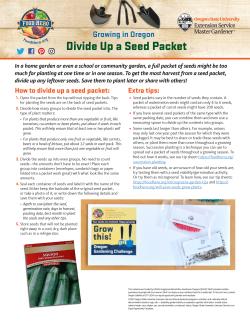In a home garden or even a school or community garden, a full packet of seeds might be too much for planting at one time or in one season. To get the most harvest from a seed packet, divide up any leftover seeds. Save them to plant later or share with others!
How to divide up a seed packet:
- Open the packet from the top without ripping the back. Tips for planting the seeds are on the back of seed packets.
- Decide how many groups to divide the seed packet into. The type of plant matters:
- For plants that produce more than one vegetable or fruit, like tomatoes, cucumbers or bean plants, put about 4 seeds in each packet. This will help ensure that at least one or two plants will grow.
- For plants that produce only one fruit or vegetable, like carrots, beets or a head of lettuce, put about 12 seeds in each pack. This will help ensure that more than just one vegetable or fruit will grow.
- Divide the seeds up into even groups. No need to count seeds—the amounts don’t have to be exact! Place each group into containers (envelopes, sandwich bags or paper folded into a packet work great) with what look like the same amounts.
- Seal each container of seeds and label it with the name of the seed. Either keep the backside of the original seed packet, or take a photo of it, or write down the following details and save them with your seeds:
- depth to sow/plant the seed, germination rate, days to harvest, packing date, best month to plant the seeds and any other tips.
- Store seeds that will not be planted right away in a cool, dry, dark place such as in a refrigerator.
Extra tips:
- Seed packets vary in the number of seeds they contain. A packet of watermelon seeds might contain only 4 to 6 seeds, whereas a packet of carrot seeds might have 200 seeds.
- If you have several seed packets of the same type with the same packing date, you can combine them and even use a measuring spoon to divide up the contents into groups.
- Some seeds last longer than others. For example, onions may only last one year past the season for which they were packaged. It may be best to share or trade these seeds with others, or plant them more than once throughout a growing season. Succession planting is a technique you can use to spread out a packet of seeds throughout a growing season. To find out how it works, see our tip sheet: https://foodhero.org/succession-planting.
- If you have old seeds, or are unsure of how old your seeds are, try testing them with a seed viability/germination activity. Or try them as microgreens! To learn how, see our tip sheets: https://foodhero.org/microgreens-garden-tips and https://foodhero.org/will-your-seeds-grow-plants.



